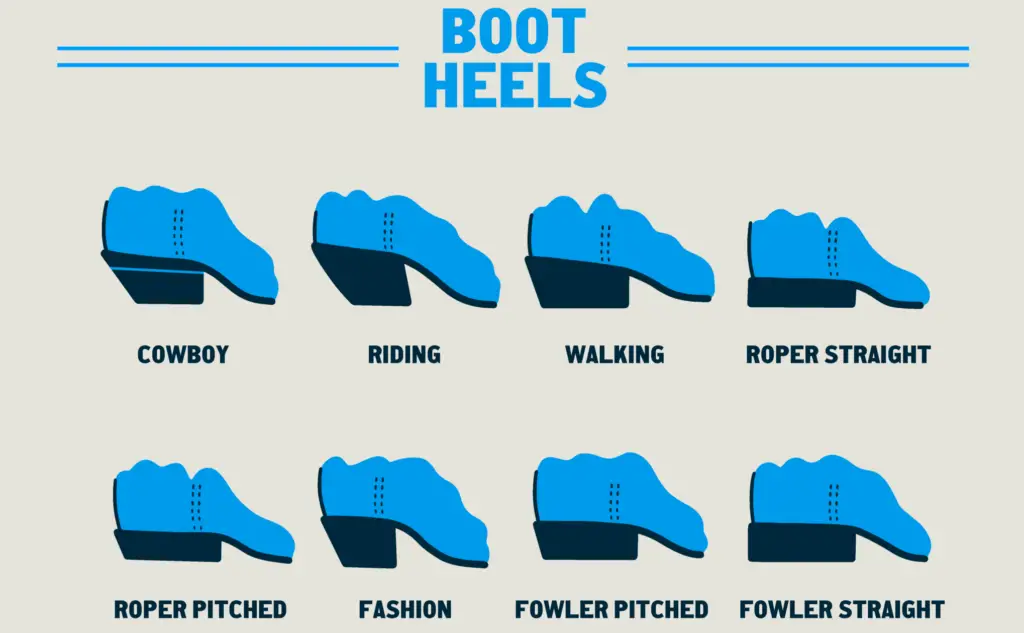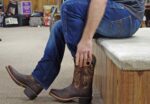Cowboy boots are known for their impeccable style and strong, durable nature. They’re an ideal pair of boots if you are someone who works in a ranch and loves to ride horses.
However, we cannot be quite sure if cowboy boots can be or should be used as work boots, especially on a construction site.
But worry not, we have done the necessary research for you to solve all your queries.
Cowboy boots are not suitable for working on construction sites or in any other heavy-duty environment. Cowboy boots have two major flaws: a high heel and a lack of traction, both of which can lead to problems and instability in a risky environment.

Construction boots must be reinforced at the heel, shank, and notably the toe, and cowboy boots must have certain unique structural features to match construction sites!
For construction work, wedge heel boots that come with safety features are suitable as it is not only comfortable, but also protects you from hazards that can occur at the construction site.
Now let’s get to know in detail why you can’t use your cowboy boots on construction sites.
1.) Outsoles
To begin with, the outsoles of cowboy boots are often made of leather and are comparatively thinner than those of a work boot.
The reason behind this is that it permits a cowboy’s foot to be as flexible as possible. However, there are a few obvious drawbacks:
-
-
- Because leather is so smooth, you won’t be getting any traction. Not to mention the amount of fixing that will be required.
- Any object on the ground can potentially harm your foot.
-
Work boots, on the other hand, have thick outsoles made of rubber that are mostly made resistant to electrical hazards and any danger your foot and ankle are exposed to.
They also provide the right amount of flexibility, durability, and traction. To balance in the concrete or scaffolding, you’ll need outsoles that can tolerate nails, debris, and have good traction.
2.) Heels
Cowboy boots have inclined heels that are usually quite high, ranging from anywhere between 1- 4 inches, so that they can secure themselves in a stirrup when riding a horse.

While this makes them ideal for horseback riding, it does not make them suitable for walking around the construction site. Also, for heavy tasks, the high heel is also not a good choice because it cannot sustain the weight on your shoulders.
While some work boots do have heels, they are normally erect, flat, and not more than an inch high. The reason for this is because you should have greater balance and can walk and move your feet freely.
For greater traction, some work boots, such as logger boots, have high heels, although most work boots don’t go higher than 1 inch.
3.) Toe design
The narrow and pointed curled up toe pockets are one of the most authentic cowboy boot features.
Cowboy boots with pointed toes, as stylish as they are, were only popular back in the days but in actual day-to-day use, there are no practical benefits, and they can even be painful. Cowboy boots with a pointed toe do not provide enough comfort for your toes when working.
Cowboy boots are also often heavier than work boots, a pair of cowboy boots can weigh up to 4 pounds, whereas a pair of work or tactical boots weighs roughly 2 pounds.
Work boots, on the other hand, are designed to get the job done and, with a few exceptions, including curved, squared, or broad square toe boxes with protective steel toe or composite toes for added protection.
4.) Insoles
The insoles of a cowboy boot are constructed of leather, just like its outsole. While leather is great for breathability, it isn’t the most comfortable material if you want to stand or walk for long periods of time.
Work boots, on the other hand, have more than just rubber beneath them. Especially when there are so many alternatives that are meant to fit the structure of your feet.
All the while, added stability, arch support, and steel shanks are included for the protection of your feet in a dangerous working environment, just like a construction site.
Cowboy boots contain no steel or composite toe or shank reinforcement. As a result, they are unable to sustain the impact of various things found on construction sites, such as nails or steel bars.
Main uses of cowboy boots
Cowboy boots, on the other hand, earn a bonus for being flexible. They don’t have much else to offer when it comes to standing for long periods of time at work. Their insoles and foot support are the reason for this.
They are actually ideal for people who live in the countryside working in ranches and riding horses.
They have two primary functions which are as follows:
1.) Working on a cattle ranch
Cowboy boots have shorter heels that are suited for farming terrain and other similar tasks.
2.) Horseback riding
The distinctive tilted heels of cowboy boots, especially those with higher heels are made to hold a rider’s foot in a horse’s stirrup for as long as feasible while crossing long distances.
So is it possible that some cowboy boots are ideal for construction sites?
Well yes, bridging the gap between both cowboy boots and work boots used for construction, some brands have come up with cowboy boots that can be regarded as a form of hybrid between cowboy and work boots for construction, spanning the gap between both cowboy boots and work boots.
They’re commonly referred to as modern or western cowboy boots with steel or composite safety toes that can withstand quite heavy impacts.
Here, we give you reasons why you can go for modern/western cowboy work boots-
1.) Many contemporary cowboy work boots contain steel or composite safety toes that can withstand extremely severe impacts. Steel toe cowboy boots, for example, can withstand 75 to 100 pounds of pressure from a sharp object landing in your toe.
Whereas a typical composite toe can endure 75 pounds of pressure and 2,500 pounds of compression that is based on ASTM standard.
2.) Furthermore, cowboy work boots frequently include Goodyear welt construction. These boots will be more durable and strong as a result of this.
3.) Almost all cowboy work boots have rubber soles that are rather thick and robust. Rubber soles are tougher, more durable, and have better grip than leather soles, therefore it’s acceptable.
Cowboy boots with rubber soles decrease the risk of nails puncturing your feet at construction sites to a bare minimum.
The soles of your feet will be safe! Rubber soles can also improve balance and stability on concrete or scaffolding by providing increased traction.
4.) Not only do cowboy work boots have reinforced toes, but they also have reinforced heels and soles to defend against electrical hazards and give comfort. Waterproof cowboy work boots are available, which is essential when working on a construction site.
5.) Another advantage of cowboy work boots over other types of work boots is their tall shafts and lack of laces. Because of their shorter shafts, cowboy work boots are substantially lighter than classic cowboy boots. Yes, most cowboy work boots are only halfway up your calf.
6.) Also, most cowboy work boots include a big toe box to give your toes more room to move around and make your feet more comfortable.
We’ve found a list of the best cowboy boots for you that are also appropriate for a construction site. When you look at these boots in general, you’ll notice that they look more like cowboy boots than work boots.
1.) Ariat Patriot Western Boots
When it comes to working in harsh outdoor conditions, this Ariat range will be your best friend. It’ll get the job done in the barn, farm, or any other outside job that demands toughness from your footwear.
Check it out here-
- RUGGED COUNTRY DESIGN
- ATRIOT’S BOOT
- 4LR TECHNOLOGY
- REMOVABLE INSOLE
Prices pulled from the Amazon Product Advertising API on:
Product prices and availability are accurate as of the date/time indicated and are subject to change. Any price and availability information displayed on [relevant Amazon Site(s), as applicable] at the time of purchase will apply to the purchase of this product.
2.) Masterson Distressed Western Cowboy Boot
These boots include a rubber outsole that is oil and chemical resistant, so you can stomp your way through just about anything.
You can check it out here-
- 100% Leather Foot and Shaft
- Shaft Height - 12”
- Heel Height - 1.75”
- Oil and Chemical Resistant Rubber Outsole. Stomp your way through just about anything.
- LONG-LASTING - All Masterson boots feature the highest level craftmanship and finest materials to ensure they are durable and long-lasting. These will be your go-to boots for years. They only get better with a
Prices pulled from the Amazon Product Advertising API on:
Product prices and availability are accurate as of the date/time indicated and are subject to change. Any price and availability information displayed on [relevant Amazon Site(s), as applicable] at the time of purchase will apply to the purchase of this product.
3.) Wolverine Rancher Steel Toe Work Boot
These boots make it on the list because they meet the ASTM standards required for a work boot. They also have a strong steel toe for your protection.
Check it out here-
- Goodyear Welt construction for added durability and strength to withstand the tough demands of any job
- A strong steel toe that meets ASTM standard F2413-11 M I/75 C75 EH
- Slip resistant rubber lug outsole to safely keep your footing in slippery conditions
- Removable orthoLite cushioned footbed for all day long comfort
- Ultra-light EVA midsole. Moisture wicking mesh lining keeps feet cool
- Full-grain leather upper looks and feels prem
Prices pulled from the Amazon Product Advertising API on:
Product prices and availability are accurate as of the date/time indicated and are subject to change. Any price and availability information displayed on [relevant Amazon Site(s), as applicable] at the time of purchase will apply to the purchase of this product.
4.) Irish Setter Steel Toe Work Boot
The steel toe is the most apparent feature of these boots, and it keeps your toes protected. Another distinguishing feature of these Irish Setter boots are the heat-resistant soles.
Check it out here-
- 11-inch pull-on steel toe work boot with full grain waterproof leather and removable polyurethane footbed
- Meets ASTM F2413-11, M/I/75/C/75 Electrical Hazard Safety Rating
- UltraDry Waterproofing system. Lining Vamp-Khaki Drill. Lining Quarter-Combat Super Knit
- RPM Composite technology to reduce weight without sacrificing comfort or durability
- Heat-Resistant Outsole - resistant to melting at a minimum of 475 Fahrenheit. Care-wipe or spray with lukewarm water after use and allow to dry naturally. If soap is required for additional cleaning,recommend using a non-scented s
Prices pulled from the Amazon Product Advertising API on:
Product prices and availability are accurate as of the date/time indicated and are subject to change. Any price and availability information displayed on [relevant Amazon Site(s), as applicable] at the time of purchase will apply to the purchase of this product.
Final words
Since you cannot use traditional cowboy boots on construction sites, but if you’re a fan of cowboy boots and want to wear them everytime, then you should go for modern cowboy work boots that are ideal for working in a construction environment too.
These modern cowboy working boots give you the best of both worlds as it comes packed with all the safety features of a work boot, also with the stylish features of cowboy boots.











